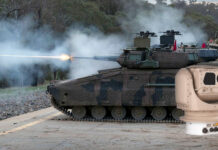Part I of a series covering the US Air Force Combat Command plans to Maintain its ‘Shooters’ Effective for Years to Come
The F-16s (Vipers) are being upgraded with several new components, primarily a larger, faster and more modern modular mission computer running a new version of the common software version M4.2, soon to be upgraded into M5+ and the introduction of Joint Helmet Mounted Cueing Systems (JHMCS) enabling the pilot to effectively point or view targets ‘heads-up’, while maintaining eye contact within a formation or with the target. Viper carrying Sniper advanced targeting pods are also being improved with upgrades introducing video data link for the pod. 12 of the 99 upgrades ordered were delivered last year. The next software upgrade planned for the F-16 is 5+, to be followed in the longer term by Version 6 and 6+ scheduled for implementation by 2012.
This upgrade will be implemented in aircraft from Block 40 and up. The most important element of this upgrade will be the implementation of a new universal armament interface, supporting the small diameter bomb (SDB-1) and AIM-120D AMRAAM missiles.
A future standard weapon interface known as UAI will simplify and accelerate the integration of new or enhanced smart weapons, simplify software interface issues between weapons and aircraft, moving weapon specific data from the aircraft to the mission planning. UAI is planned for integration into future F-16 through the next decade, as it matures to become a standard, enhancing the current 1790 protocol.
The capability to carry small diameter bombs on the F-16 will markedly expand the weapon load of the F-16 Viper. It will also expand the support for Litening targeting pods (through the use of existing interfaces). This upgrade will also implement a major improvement in navigation precision, introducing Differential GPS Correction capability. The aircraft will be fitted with modern IFF Mode 5.
Among the most essential upgrades are improvements in communications, introduction of new datalinks, and the capability to carry new weapons. For example, the introduction of ARC-210 SLOS radios provide ‘shooters’ with the capability to directly communicate with ground forces. This radio has anti-jam FM/AM capability covering VHF/UHF wavebands, supporting both air/air and air/ground communications. These radios, designed as ‘form fit’ replacement for older radios, filled an essential capability gap in theater and received excellent reviews from pilots in theater.
Another important improvement embedded in the F-16s was the night vision cueing display, enabling pilots to better employ their weapons at night. Equally important for rapid engagement is the introduction of Situational Awareness Datalink (SADL) in the F-16s. This low-rate datalink enables F-16s to engage time sensitive targets within few minutes, compared to at least half an hour required with pre-SADL procedures.
In the following pages, Defense Update reports how the USAF plans to maintain its ‘Shooters’ effective for years to come.
- Keeping the Old Horses Flying
- Boeing F-15E Strike Eagle
- Lockheed Martin F-16 Viper



















